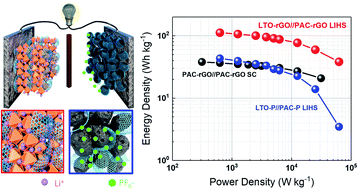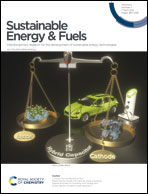Balancing the anode and cathode using a reduced graphene binder for boosting both energy and power density of hybrid supercapacitors†
Abstract
Lithium-ion hybrid supercapacitors (LIHSs) are drawing extensive attention owing to their combined merits of high energy density and high power density. However, the kinetics imbalance between the anode and the cathode is a major challenge that needs to be overcome. In this work, we demonstrate high-performance LIHSs consisting of a properly balanced Li4Ti5O12 (LTO) anode and a porous activated carbon (PAC) cathode using reduced graphene oxide (rGO) as a multifunctional conductive binder. The rGO binder holds the active particles in electrical percolation networks, leading to facilitated ion diffusion and transport in both LTO- and PAC-based electrodes. The rGO binders incorporated into LTO electrodes (LTO–rGO) lead to lower polarization and better kinetics of Li+-ion insertion/extraction during the electrochemical reaction process. Simultaneously, the rGO binders effectively maintain a larger accessible surface area of PAC particles in PAC electrodes (PAC–rGO), resulting in greatly enhanced specific capacitance. Owing to the synergistic performance of the LTO–rGO anode and PAC–rGO cathode, the resultant LIHSs are capable of not only delivering a pre-eminent energy density of up to 112 W h kg−1 but also an ultra-high power density of 62.5 kW kg−1.



 Please wait while we load your content...
Please wait while we load your content...